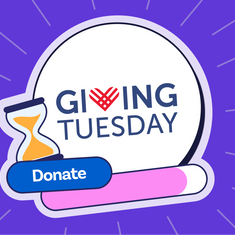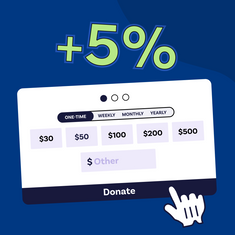
With our fundraising plan template, we’ll walk you through everything you need to know about drafting your own campaign fundraising plan.
What does every nonprofit and charity have in common? They all need a fundraising plan for each campaign!
A fundraising plan template will help you organise and maximise your campaign’s success. It doesn’t matter what your organisation does, or who or what you’re raising money for. Without a strategic plan, you’ll be leaving money on the table.
Luckily, whether you’re planning a peer fundraising campaign or an active fundraising event like a 5k race, most fundraising plans follow a similar formula:
- Determine your desired outcome
- Set fundraising goals and benchmarks
- Define a budget
- Decide on a fundraising tactic
- Create a timeline
- Give your campaign a test run
- Market your event or campaign
- Launch your campaign
- Send out “thank yous” and analyse your results
Let’s explore each of the steps in a typical fundraising plan template, using a peer-to-peer campaign as an example. Keep in mind, this is for a single campaign, not your organisation’s overall fundraising strategy.
1. Determine Your Desired Outcome
Your fundraising campaign’s goals are really the heart of what your efforts are all about. In fact, you should consider them the foundation of your entire plan, from conception to completion.
Before you define your budget, audience, or fundraising goal, you should think about what you want to get out of your fundraising campaign. What are you hoping to do and achieve with the funds you raise? Are you looking to increase awareness and the engagement of your supporters? Who will benefit from your campaign? Which fundraisers and donors will you target as your intended audience?
Your desired outcome will serve as your campaign’s North Star, and will help you determine the rest of your decisions.
2. Set Fundraising Goals and Benchmarks
Let’s assume you’ve decided on a peer-to-peer campaign. If you do a specific annual fundraising campaign, you can look to your previous year’s metrics to get an idea of what your goals should be. If this is your first peer-to-peer campaign, no worries! As long as your goals are clearly defined, your chances of hosting a successful fundraising campaign will go way up.
We recommend setting SMART goals. This means they’re:
✅ Specific: Your goal should be precise
✅ Measurable: Your goal needs to be quantifiable
✅ Achievable: Your goal is realistic and you have the necessary resources
✅ Relevant: Your goal aligns with your overall efforts
✅ Time-Bound: Your goal has a set deadline
Let’s say your nonprofit is a breast cancer foundation. You formed it after surviving breast cancer, and every year host a walk-a-thon to raise money for cancer research. Last year, your nonprofit raised $22,000 and acquired 50 new donors.
Here are some examples of SMART goals:
Goal 1: Raise $25,000 for breast cancer research by hosting your annual walk-a-thon on Sept 7.
🎯 Specific: You want to raise $25,000 for breast cancer research during your annual walk-a-thon.
📈 Measurable: Your goal is measurable in dollars.
🏆 Achievable: Your nonprofit raised $22,000 last year. Increasing your fundraising revenue to $25,000 this year seems achievable.
🙌 Relevant: You’ve hosted walk-a-thons before to great success.
🗓 Time-Bound: You have until the end of Sept. 7 to achieve your goal.
Goal 2: Increase your number of new donors to 60 by the end of the walk-a-thon.
🎯 Specific: You want 60 new donors to give during your annual walk-a-thon.
📈 Measurable: Your goal is measurable in your number of new donors.
🏆 Achievable: You acquired 50 new donors last year. Acquiring 60 this year seems reasonable.
🙌 Relevant: You’ve hosted walk-a-thons before to great success.
🗓 Time-Bound: You have until the end of Sept. 7 to achieve your goal.
3. Define a Fundraising Budget
It’s time to crunch the numbers. As we just mentioned, it’ll come in handy to first review your budget and expenses from last year.
Create a spreadsheet that lists the items and costs of everything you need to budget for. Here are a few line items to consider:
- Fundraising platform costs (unless the platform is free)
- Personnel and administrative expenses
- Credit card processing fees
- Marketing costs (direct and indirect)
- Social media advertising
- Fundraising consultant fees
If this is your first campaign of this nature, do your research to estimate roughly how much each of these items may cost. Luckily with a peer-to-peer fundraising campaign, you might find that a small budget can go a long way
4. Decide on a Fundraising Tactic
Here are a few questions you should ask yourself, your staff, and maybe even your active board members:
❓ What is your fundraising campaign’s message? It should be tangible, clear, concise, and emblematic of your organisation’s work.
❓ What type of fundraising campaign do you want to do? Are you planning a Facebook birthday fundraiser, social media challenge, grassroots community effort, etc.?
❓ Are you going to focus solely on individual donors or teams? Corporate sponsorships? Public figures or influencers? Some combination of the three?
❓ How will you encourage major donors to give more? Are you going to gamify your fundraiser by encouraging team members to compete against one another
to rank on a leaderboard? Will you entice them with major gifts for each donation level?
❓ What fundraising software will you use to track and quantify the success of your campaign?
The questions might feel endless at first, but they’re key to settling on a fundraising idea and getting the planning process started. Ultimately, you’ll be glad you spent the time preparing up front.
You may find yourself revisiting and updating your basic plan as you go, and that’s okay! Your answers to these questions are meant to give you direction — they’re not etched in stone … yet.
If you feel like you need a little help, we have multiple free campaign templates for you to use.
5. Create a Timeline
Now that you’ve identified your goals, budget estimates, and approach, it’s time to put everything together. Create a fundraising campaign timeline, and fill it out thoroughly with each step of the process to launch your campaign — remember, details matter!
Your timeline will serve as your team’s roadmap throughout your campaign and keep everything on track. Think of it as a checklist that you’ll complete to execute your fundraising efforts. This could include creating a campaign website, scheduling social media posts, sending email blasts, and obtaining donor prizes.
Review it with your team to ensure you’ve covered all your bases and your timeline is realistic, then assign tasks accordingly.
Pro tip: Sometimes it’s easier to start at your campaign’s launch date, then work backwards.

6. Give Your Campaign a Test Run
Go over your campaign before launching it to identify any potential errors. If something isn’t working, it’s better to fix it before, rather than during.
Review your event’s timeline, determine when you’ll engage with your donors, and what you’ll say. Ask your team for feedback, and make corrections as you go.
You should also test your idea with your regular, long-term donors and supporters to get their feedback. For a peer-to-peer campaign, they could offer some insight, like what attracts their followers, or how to clarify your overall message.
The more prepared you are, the more successful your efforts are likely to be.
7. Market Your Campaign
With your nonprofit fundraising campaign in place, it’s time to start marketing! There are literally hundreds of ways to market to your current donors. For example, if you’re running a peer-to-peer fundraising campaign, here are a few marketing tactics to consider:
📢 Create a landing page on your website highlighting your campaign, complete with an effective call to action and a user-friendly donation form.
📊 Create a wealth of organic content (copy, photos, videos, charts, graphs, etc.) to share on your website and social media.
📲 Post about your campaign on social media, and encourage your donor base to get their peers involved.
📝 Create an online petition, manifesto, or declaration to generate a list of potential donors prior to your campaign launch.
🧑🏽💻 Start an email marketing campaign. The average open rate for nonprofit emails is 25.17%, compared to the average open rate across a spectrum of industries, which is only 21.33%.
🗞 Contact media partners — like your local newspapers, radio, and other relevant sources — that may be inclined to boost your message.
8. Launch Your Campaign
You’re ready to launch! Congratulations! All your planning and hard work has led you to this point.
There are three key things you need to focus on at this point:
- Engage with your donors. This will help you leave a memorable impression and improve your donor retention rates.
- Have fun! If you’re enjoying yourself, your donors will, too — and in some cases, they’ll be inclined to donate more.
- Be flexible. Sometimes supporters will provide helpful feedback during your campaign, or you may need to make tweaks to adapt to changing circumstances. Also, it never hurts to have a back-up plan, just in case!
9. Send Out Thank-You Notes and Analyse Your Results
The final step to build into your fundraising plan is to thank donors. Thank your donors throughout the entire event, not just when they’re donating to your cause. After your fundraising event ends, thank them again for participating and share your campaign’s impact and success. Tell donors what you’ll be able to do with the funds raised, and stay upbeat, optimistic, and appreciative, even if you didn’t reach your goal (now you’ve got a goal for next year!).
In addition to thanking your donors, meet with your team and analyse the results of your fundraising efforts. Now that you have data, you can look back on every step of the campaign and determine what went well and what you can improve upon next time. The more you learn, the better chances you’ll have at running successful campaigns in the future.
A Fundraising Plan Template Can Organise Your Campaign
Not every campaign will emphasise each of the steps we’ve mentioned in this fundraising plan template, but it’s a general format that can help you map out your ideas. We know that planning a fundraising campaign can be a challenge. At Raisely, we’re simplifying the process with an all-in-one fundraising platform that provides plenty of tools to get a headstart on your next campaign, including easy website creation, a signature three-step donation form, and more.
Ready to create your
next campaign?
Anthony Greer is a freelance content writer who crafts consistent, engaging, on-brand copy for nonprofits, real estate, and digital marketing agencies.





